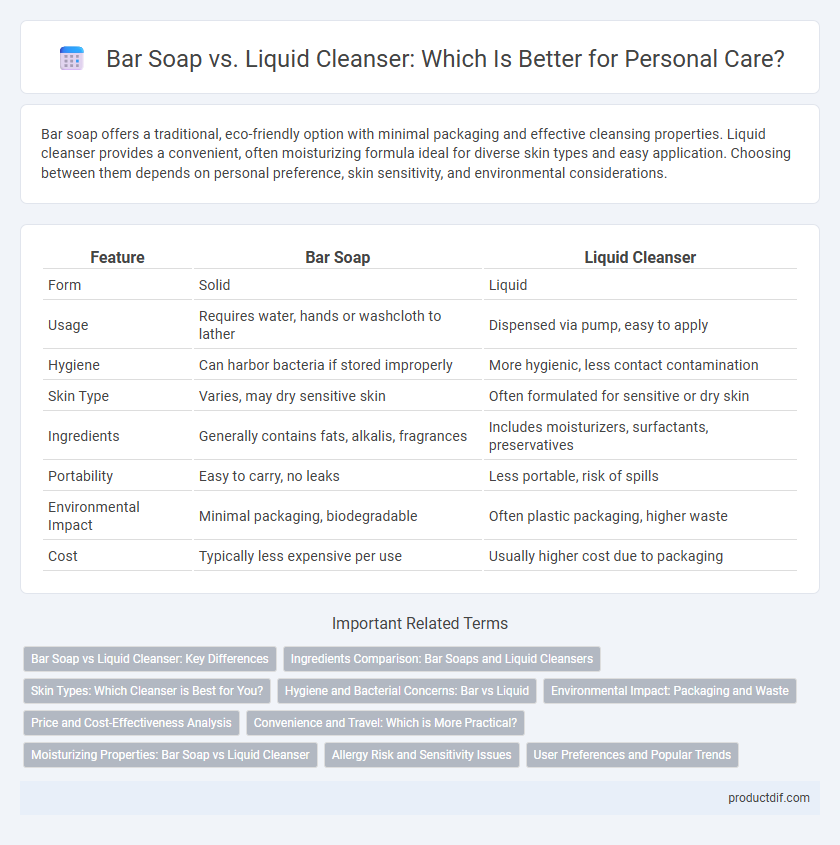Bar soap offers a traditional, eco-friendly option with minimal packaging and effective cleansing properties. Liquid cleanser provides a convenient, often moisturizing formula ideal for diverse skin types and easy application. Choosing between them depends on personal preference, skin sensitivity, and environmental considerations.
Table of Comparison
| Feature | Bar Soap | Liquid Cleanser |
|---|---|---|
| Form | Solid | Liquid |
| Usage | Requires water, hands or washcloth to lather | Dispensed via pump, easy to apply |
| Hygiene | Can harbor bacteria if stored improperly | More hygienic, less contact contamination |
| Skin Type | Varies, may dry sensitive skin | Often formulated for sensitive or dry skin |
| Ingredients | Generally contains fats, alkalis, fragrances | Includes moisturizers, surfactants, preservatives |
| Portability | Easy to carry, no leaks | Less portable, risk of spills |
| Environmental Impact | Minimal packaging, biodegradable | Often plastic packaging, higher waste |
| Cost | Typically less expensive per use | Usually higher cost due to packaging |
Bar Soap vs Liquid Cleanser: Key Differences
Bar soap offers a solid, travel-friendly format that typically contains fewer synthetic ingredients and preservatives than liquid cleansers. Liquid cleansers provide a more hygienic option with easy application and usually include moisturizing agents, making them suitable for sensitive or dry skin. Both products vary in pH levels, formulation, and environmental impact, influencing consumer choice based on skin type and personal preferences.
Ingredients Comparison: Bar Soaps and Liquid Cleansers
Bar soaps typically contain natural oils, fats, and alkaline substances like sodium hydroxide, providing a solid form with minimal preservatives. Liquid cleansers often include synthetic detergents, emulsifiers, and added moisturizing agents such as glycerin or hyaluronic acid to enhance hydration. The ingredient composition affects pH levels and skin compatibility, with bar soaps tending to be more alkaline and liquid cleansers formulated to be closer to the skin's natural pH.
Skin Types: Which Cleanser is Best for You?
Bar soap tends to be more effective for oily and normal skin types due to its deep cleansing properties and lower water content, which helps remove excess oil without stripping natural moisture. Liquid cleansers are generally gentler, making them ideal for sensitive, dry, or combination skin by providing hydration and minimizing irritation. Choosing between bar soap and liquid cleanser depends largely on your specific skin needs, with bar soap offering thorough cleansing and liquid cleansers promoting hydration and soothing benefits.
Hygiene and Bacterial Concerns: Bar vs Liquid
Bar soap can harbor bacteria on its surface after multiple uses, potentially transferring germs between users, whereas liquid cleansers in pump bottles dramatically reduce this risk by preventing direct contact. Studies show liquid cleansers maintain higher hygiene standards in public or shared environments due to their sealed dispensing system. However, properly rinsed and dried bar soap remains effective and safe for individual use, minimizing bacterial buildup when stored correctly.
Environmental Impact: Packaging and Waste
Bar soap typically generates less plastic waste due to its minimal and often biodegradable packaging, reducing landfill contribution compared to liquid cleansers, which commonly use plastic bottles. The manufacturing and transportation of bar soap also tend to have a lower carbon footprint because it is lighter and more compact, requiring less energy and fuel. Liquid cleansers often contain more water, increasing packaging volume and waste, whereas bar soaps concentrate ingredients, leading to reduced environmental burden.
Price and Cost-Effectiveness Analysis
Bar soap typically costs between $1 and $3 per unit and lasts longer due to concentrated use, making it more cost-effective than liquid cleansers, which average $4 to $8 per bottle. Liquid cleansers often contain added moisturizers and antibacterial agents but require more product per application, increasing overall expenditure. For budget-conscious consumers, bar soap offers greater longevity and lower price per use, enhancing cost-efficiency in personal care routines.
Convenience and Travel: Which is More Practical?
Bar soap offers compactness and solid form, making it highly convenient for travel as it doesn't risk leakage and fits easily in small toiletry bags. Liquid cleansers provide ease of application and quick rinsing, but their bulkier packaging and potential for spillage can be less practical on the go. For frequent travelers prioritizing portability and mess-free use, bar soap often stands out as the more practical choice in personal care.
Moisturizing Properties: Bar Soap vs Liquid Cleanser
Bar soaps often contain natural oils and glycerin that provide deep moisturizing benefits, helping to maintain the skin's hydration barrier. Liquid cleansers are typically formulated with humectants and emollients like hyaluronic acid and aloe vera, offering enhanced moisture retention and a gentler cleansing experience for sensitive or dry skin. Choosing between bar soap and liquid cleanser depends on skin type, with liquid cleansers generally favored for superior hydration and less potential for skin dryness.
Allergy Risk and Sensitivity Issues
Bar soap often contains fewer synthetic ingredients and preservatives, reducing allergy risk and suitability for sensitive skin compared to some liquid cleansers, which may include fragrances and chemicals that trigger reactions. Individuals with skin sensitivity benefit from hypoallergenic, fragrance-free formulations commonly found in specialized bar soaps. Dermatological studies indicate that liquid cleansers with harsh detergents can disrupt the skin barrier, increasing sensitivity and irritation potential.
User Preferences and Popular Trends
Bar soap remains favored for its eco-friendly packaging and longevity, appealing to environmentally conscious users. Liquid cleansers dominate with their convenience, moisturizing properties, and variety, attracting consumers seeking gentle and nourishing skincare options. Current trends show an increasing preference for natural ingredients in both formats, reflecting a broader shift toward sustainable and skin-friendly personal care products.
Bar soap vs Liquid cleanser Infographic

 productdif.com
productdif.com